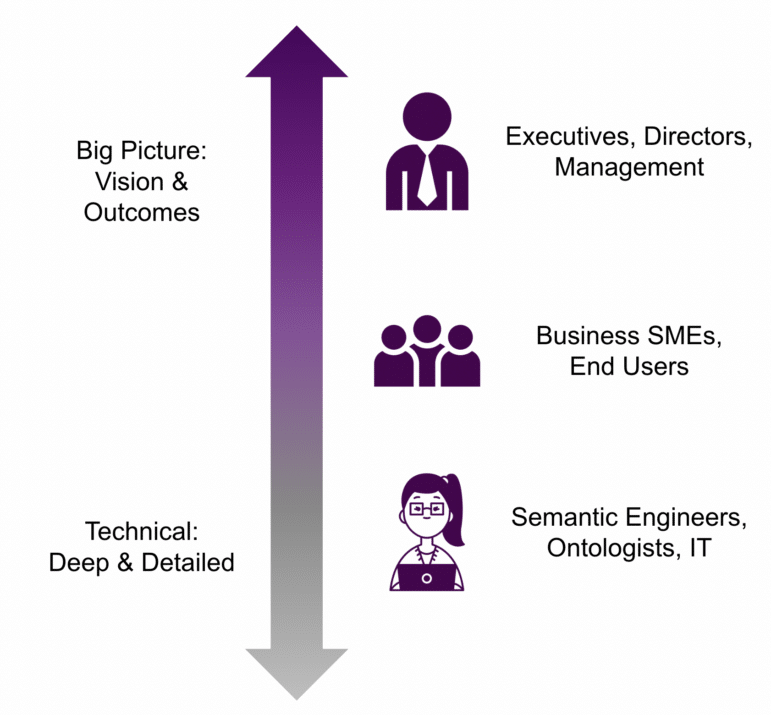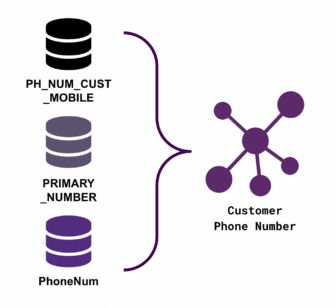Recently, I’ve been thinking a lot about how we can better explain complex, semantic concepts like ontologies, knowledge graphs, and data fabrics to others in an approachable, easy-to-understand manner. I’ve been in any number of situations where I’ve struggled to explain ontologies, and most often, it’s because I jumped too quickly into the details, or because I didn’t have clear outcomes or goals for the conversation.
No matter whether you are a consultant, an individual contributor, or a manager of a technical team, we all find ourselves explaining what an ontology is, how it will benefit an organization, and the best ways to get started. While this blog focuses on tips and examples for explaining ontologies, I’ve found these tips helpful for any conversation explaining semantic concepts.
Set Intentions and Outline the Big Picture
Every successful presentation or productive conversation begins with setting and recognizing intentions.  Understanding both your own, and your audience’s intentions will help you to tailor your message and ensure understanding.
Understanding both your own, and your audience’s intentions will help you to tailor your message and ensure understanding.
As a presenter, what outcomes am I looking for from this discussion?
As an audience member, what are they looking to learn, understand, apply, or receive?
There are many reasons why ontologists and other semantic SMEs need to explain ontology, including interviewing for a new role or job, pitching new project ideas, getting funding for new tools, and growing their teams. In each of these situations, the audience may need to understand the essentials of ontologies to varying degrees, and it is the role of the presenter to ensure that the audience’s specific level of understanding is reached.
For example, I’ve been working on a project recently that sought to solicit funding for ontology management tooling to support federated data access and governance across a large organization. The project lead needed a strong case to present to leadership to elicit support and funding. In this case, their WHY is not just needing tooling, but needing tooling to support critical business processes (federated contributions to the ontology) in an approachable way, thus embedding governance directly within the daily workflow.
A common mistake is diving too quickly into the weeds, without first framing the discussion for your audience. For many of them, a lot of the topics you will touch on may be new to them, or still mainly theoretical in nature. It’s your responsibility as the presenter to do your best to ensure they can take a theoretical concept from your presentation and apply it to their work or their projects. There are a few questions that I always ask myself to help craft the big picture:
1. What do you need out of this conversation?
Are you looking for alignment on terminology? Resources for a new project? Sharing best practices? A detailed modeling conversation? Funding for an ontology management tool?
2. Who is your audience?
Are you presenting to Data Scientists? Ontologists? Executives? What is their background and what level of understanding do they walk in with?
3. What do they need to know in order for you to achieve your goals or to answer your question?
Our project lead above was looking for funding for new ontology management tooling and in order to elicit support, they would need to explain the need, the business value, and likely some technical concepts like RDF, OWL, or SHACL to describe what the tooling is ultimately for. Depending on the audience, the amount of explanation in each area may vary.
Drive Interaction and Engagement
Now that you’ve set intentions and outlined the big picture, it is important to keep this vision in mind throughout the conversation. There are specific actions you can take within a conversation that help to achieve this goal.
Use examples, anecdotes, and visuals
Never underestimate the importance of being able to tie conceptual conversations to practical, day-in-the-life examples.  If you are trying to gain alignment across an enterprise on the importance of using ontologies for data standardization, for example, remind your audience of real life examples of messy, duplicative, or hard to find data. Show them how having a single definition of a data element across all departments will add value in reporting across functions, as will having a 360 degree view of your customers, data, or technologies. For example, if you have multiple systems that produce or consume customer data, the same attribute may have many names depending on the system. An ontology can help to standardize this data across systems by creating a single definition and common, human-readable name for Customer Phone Number.
If you are trying to gain alignment across an enterprise on the importance of using ontologies for data standardization, for example, remind your audience of real life examples of messy, duplicative, or hard to find data. Show them how having a single definition of a data element across all departments will add value in reporting across functions, as will having a 360 degree view of your customers, data, or technologies. For example, if you have multiple systems that produce or consume customer data, the same attribute may have many names depending on the system. An ontology can help to standardize this data across systems by creating a single definition and common, human-readable name for Customer Phone Number.
Anecdotal, real-life examples are critical for ensuring your audience walks away with a practical understanding of how your presentation applies to them.
Co-create and make your audience part of the conversation
In addition to anecdotes and visuals, guide your audience through hands-on activities that apply the complex concepts of ontology design, tooling, or governance. This not only helps them better understand, but also gives them a sense of ownership in the final outcome – they’ve had a hand in reaching the goal. For ontology design, this might be a quick demo of an initial design, live prototyping of a feature that will help them complete a task better in the future, or an activity to collaboratively define personas and user stories.
Engaging your audience isn’t limited solely to the initial conversation, but is also relevant when following up after the conversation. Re-engaging your audience after the initial conversation might include sending updates after a tool has been acquired, inviting them to demos or to participate in design, and sending memos about the outcome of the ontology after it’s been “realized.”
Pause often and check in on your audience
Last, but definitely not least, build in time to pause and give your audience time to digest, to ask questions, or to repeat back to you, in their own words, what they have come to understand from your conversation. Remember an audience member’s intention and background when answering their questions (i.e., try to think about what they need to know rather than what they are specifically asking). When formulating your response to an audience member’s question, think about the following prompts before jumping into the details:
Why might they be asking this question?
How does it relate to their goals?
What do they need to know from my answer to achieve their needs?
Remembering both your own, and your audience’s intentions from beginning to end will ensure a more productive conversation built on solid understanding.
Following these tips have helped me to have productive conversations with non-technical audiences about very complex topics related to ontologies and knowledge graphs. For more tips, or for help presenting the business case of knowledge graphs, tooling, and more, reach out to us and learn more.
